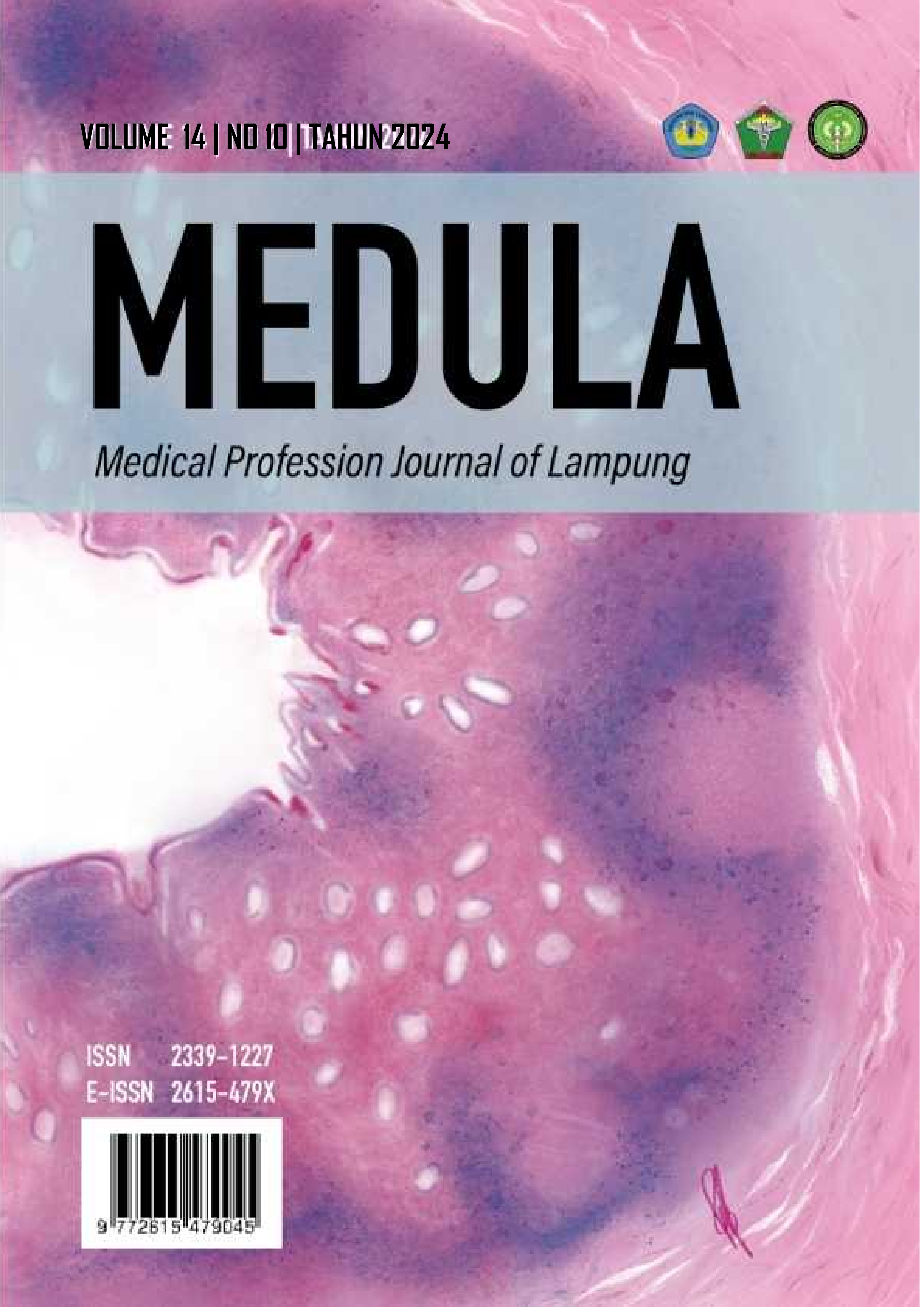Literature Review: Antioxidant Activity of Water Apple Leaves (Syzygium aqueum)
DOI:
https://doi.org/10.53089/medula.v14i10.1321Abstract
Antioxidant is a complex inhibit, prevent or dampen the reactions of free radicals and oxidants, as well as to prevent tissue damage. Antioxidant works by donating one of its electron to oxidant compounds thereby inhibiting the activity of these oxidant compounds. An imbalance between antioxidants and free radicals, where free radicals are more prevalent, can damage molecular organisms and cause oxidative stress that triggers damage to body cells. Oxidative damage to DNA triggers mutations that initiates cancer, cardiovascular disease, neurodegenerative disorder, autoimmune diseases, aging processes and several hereditary diseases. Currently, the use of natural antioxidants as traditional treatments is widely consumed by the community. Natural antioxidants are found in several plant sources, it is known to be more affordable and have lower side effects, making it as popular treatment choice in the community. One of the plants with a high antioxidant content is the water apple leaf (Syzygium aqueum) which rich in flavonoids, phenolics, and tannins. DPPH (2,2-diphenyl-1-picrylhydrazyl) is a common method to measure antioxidant activity, it works with the principle of hydrogen capture from antioxidants by free radicals. The parameter IC50 is used to represents the sample concentration required to capture 50% of DPPH radicals. Several studies using the DPPH method have shown that water apple leaves have strong antioxidant activity, indicated by its low IC50 value. The lower the IC50 value, the stronger the antioxidant activity.
References
Sies H. Oxidative Stress: A Concept In Redox Biology And Medicine. Redox Biology. 2015; 4: 180–183.
Arief H, Widodo MA. Peranan Stres Oksidatif Pada Proses Penyembuhan Luka. Jurnal Ilmiah Kedokteran Wijaya Kusuma. 2018; 5(2): 22.
Sari AN. Potensi Antioksidan Alami Pada Ekstrak Daun Jamblang (Syzigium cumini(L.) Skeels). 2017; 18(2): 107–112.
Handajani F. Oksidan dan Anti Oksidan Pada Beberapa Penyakit dan Proses Penuaan. Sidoarjo: Zifatama Jawara; 2019: 19-69.
Urquiza-Martínez MV, Navarro BF. Antioxidant Capacity Of Food. Free Radicals And Antioxidants. 2016; 6(1): 1–12.
Mulianto N. Malondialdehid Sebagai Penanda Stres Oksidatif Pada Berbagai Penyakit Kulit. Cermin Dunia Kedokteran. 2020; 47(1): 39–44.
Sayuti K, Yenrina R. Antioksidan Alami dan Sintetik. Padang: Andalas University Press; 2015: 31-32.
Arulselvan P, Fard MT, Tan WS, Gothai S, Fakurazi S, Norhaizan ME. Role of Antioxidants and Natural Products in Inflammation. Oxidative Medicine and Cellular Longevity. 2016; 2016: 1-15.
Sonawane MS. Dietary Benefits Of Watery Rose Apple (Syzygium aqueum (Burm.F.) Alston). International Archive Of Applied Sciences And Technology. 2018; 9(4): 126–129.
Anggrawati PS, Ramadhania ZM. Review Artikel: Kandungan Senyawa Kimia dan Bioaktivitas Dari Jambu Air (Syzygium aqueum Burm. F. Alston). Farmaka. 2018; 14(2): 331–334.
Hariyati T, Jekti DSD, Andayani Y. Pengaruh Ekstrak Etanol Daun Jambu Air (Syzygium aqueum) Terhadap Bakteri Isolat Klinis. Journal Penelitian Pendidikan IPA. 2015; 1(2): 1–12.
Lase F, Lubis N, Harahap AS. Ekoenzim dan Pengaruhnya Terhadap Pertumbuhan Stek Jambu Air Madu Deli Hijau (Syzygium aqueum). Medan: Tahta Media Group; 2023: 1-2.
Kausar RA, Putra ASE, Tutik. Hubungan Kadar Flavonoid Dengan Aktivitas Antioksidan Pada Daun Jambu Air (Syzygium Aqueum) dan Daun Kelor (Moringa Oleifera) Menggunakan Spektrofotometri UV-Vis. Jurnal Analis Farmasi. 2023; 8(2): 170–187.
Panche AN, Diwan AD, Chandra SR. Flavonoids: An Overview. Journal Of Nutritional Science. 2016; 5: 1-15.
Setiawan F, Yunita O, Kurniawan A. Uji Aktivitas Antioksidan Ekstrak Etanol Kayu Secang (Caesalpinia sappan) Menggunakan Metode DPPH, ABTS, dan FRAP. Media Pharmaceutica Indonesiana. 2018; 2(2): 82–89.
Mokoginta RV, Simbala HEI, Mansauda KL. Uji Aktivitas Antioksidan Ekstrak Etanol Bulbus Bawang Dayak (Eleutherine americana merr) Dengan Metode DPPH (1,1-Diphenyl-2-Picrylhydrazyl). Pharmacon. 2020; 9(3): 451.
Auliasari N, Gozali D, Santiani A. Formulasi Emulgel Ekstrak Daun Jambu Air (Syzygium aqueum (Burm. F.) Alston) Sebagai Antioksidan. Jurnal Farmako Bahari. 2016; 7(2): 1–11.
Sundoro AK, Syukur M, Elisa N. Penentuan Nilai IC 50 Ekstrak Daun Jambu (Syzygium Aqueum). 2024; 13(2): 176–180.
Primadiastri IZ, Wulansari ED, Suharsanti R. Perbandingan Kandungan Fenolik Total, Flavonoidtotal dan Aktivitas Antioksidan Ekstrak Etanol daun Jambu Bol (Syzigium malaccense L.) dan Daun Jambu Air Kancing (Syzigium aqueum). Media Farmasi Indonesia. 2021; 16(2): 1170– 1676.
Rusydi SH, Indrawati T, Djamil R. Formulasi Spray Gel Antioksidan Kombinasi Ekstrak Daun Jambu Air dan Ekstrak Daun Mangga. Majalah Farmasetika. 2022; 7(2): 141.
Zaen DM, Ekayanti M. Penetapan Flavonoid Total Dan Uji Aktivitas Antioksidan Ekstrak Etanol Dari Daun Jambu Air (Syzygium aqueum), Daun Jambu Bol (Syzygium malaccense) dan Daun Jamblang (Syzygium cumini). Jurnal Kedokteran Universitas Palangka Raya. 2022; 10(2): 15–18.
Sobeh M, Mahmoud MF, Petruk G, Rezq S, Ashour ML, Youssef FS. Syzygium Aqueum: A Polyphenol- Rich Leaf Extract Exhibits Antioxidant, Hepatoprotective, Pain-Killing And Anti-Inflammatory Activities In Animal Models. Frontiers In Pharmacology. 2018; 9(566): 1–14.
Itam A, Wati Ms, Agustin V, Sabri N, Jumanah RA, Efdi M. Comparative Study Of Phytochemical, Antioxidant, And Cytotoxic Activities And Phenolic Content Of Syzygium aqueum (Burm. F. Alston F.) Extracts Growing In West Sumatera Indonesia. Scientific World Journal. 2021; 2021: 1-9.
Downloads
Published
How to Cite
Issue
Section
License
Copyright (c) 2025 Medical Profession Journal of Lampung

This work is licensed under a Creative Commons Attribution-ShareAlike 4.0 International License.














